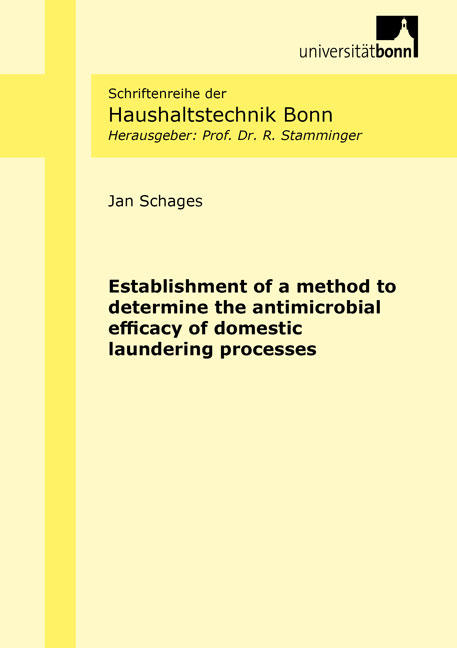
Establishment of a method to determine the antimicrobial efficacy of domestic laundering processes
Seiten
2020
Shaker (Verlag)
978-3-8440-7509-0 (ISBN)
Shaker (Verlag)
978-3-8440-7509-0 (ISBN)
During the last decades striving for energy efficiency led to lower washing temperatures in laundering processes. In this regard, there is a rising need to measure the antimicrobial action of laundry detergents and additives used in domestic laundering, since chemistry must be considered an important means to compensate for the loss of temperature. Although there is an existing standard method (EN 16616) to evaluate the antimicrobial efficacy of detergents and laundering for the medical area, this method does not reflect the domestic situation and neglects important steps like the rinsing cycle.
Hence, this study aimed to develop an experimental setup which represents the whole washing process and reflects the domestic situation by using a household-related setting. In the suggested method a lab-scale washing machine is used, allowing not only the test of products that can be applied throughout the laundering process (including the rinsing cycle) but also being able to show the impact of different parameters in a highly systematic manner. In particular, the impact on the antimicrobial efficacy of main wash detergents with and without activated oxygen bleach and detergents consisting of quaternary ammonium compounds used in the rinsing cycle as well as the effect of different temperatures and durations were considered.
This study showed that a lab-scale washing machine is suitable to simulate domestic laundering processes and can be used to investigate parameters influencing the antimicrobial efficacy of one washing process. It is difficult to separately evaluate the impact of the four factors of the Sinner´s principle time, temperature, mechanical action and chemistry in a domestic washing machine while these can be investigated individually in a lab-scale device.
Hence, this study aimed to develop an experimental setup which represents the whole washing process and reflects the domestic situation by using a household-related setting. In the suggested method a lab-scale washing machine is used, allowing not only the test of products that can be applied throughout the laundering process (including the rinsing cycle) but also being able to show the impact of different parameters in a highly systematic manner. In particular, the impact on the antimicrobial efficacy of main wash detergents with and without activated oxygen bleach and detergents consisting of quaternary ammonium compounds used in the rinsing cycle as well as the effect of different temperatures and durations were considered.
This study showed that a lab-scale washing machine is suitable to simulate domestic laundering processes and can be used to investigate parameters influencing the antimicrobial efficacy of one washing process. It is difficult to separately evaluate the impact of the four factors of the Sinner´s principle time, temperature, mechanical action and chemistry in a domestic washing machine while these can be investigated individually in a lab-scale device.
| Erscheinungsdatum | 17.08.2020 |
|---|---|
| Reihe/Serie | Schriftenreihe der Haushaltstechnik Bonn ; 2020,3 |
| Verlagsort | Düren |
| Sprache | englisch |
| Maße | 148 x 210 mm |
| Gewicht | 149 g |
| Themenwelt | Naturwissenschaften ► Biologie ► Mikrobiologie / Immunologie |
| Technik ► Maschinenbau | |
| Schlagworte | Antimicrobial efficacy • domestic laundering • Method Development • Microbiology • washing machine |
| ISBN-10 | 3-8440-7509-7 / 3844075097 |
| ISBN-13 | 978-3-8440-7509-0 / 9783844075090 |
| Zustand | Neuware |
| Haben Sie eine Frage zum Produkt? |
Mehr entdecken
aus dem Bereich
aus dem Bereich
Allgemeine Grundlagen und spezielle Anwendungen
Buch | Softcover (2021)
Springer Berlin (Verlag)
54,99 €


